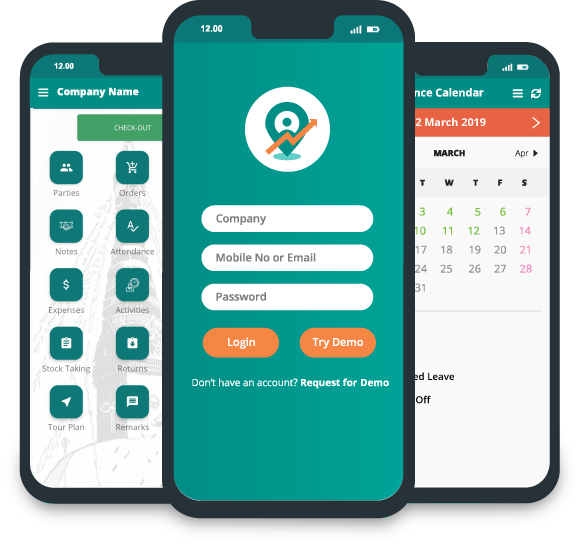The Rise of Selfie Attendance: A Smarter Way to Track Field Employees
_1743655384.png)
In an age where remote work, field teams, and distributed operations are the norm, traditional attendance systems are struggling to stay relevant. What once worked inside four office walls—manual registers, biometric machines, or swipe cards—now fails to meet the needs of a mobile, flexible workforce.
The workplace has evolved. It's time for attendance tracking too.
Enter selfie attendance—a smart, mobile-first, and verifiable system that allows employees to mark their presence by simply taking a selfie. With facial recognition and GPS verification, companies can now track attendance in real-time, from any location, without compromising on accuracy or accountability.
This isn't just a convenience; it's a competitive advantage for organizations managing field staff, hybrid teams, or remote workers.
Let’s explore how selfie attendance works, why it’s becoming a game-changer, and how it compares to traditional systems.
What Is Selfie Attendance?
Selfie attendance is a modern attendance tracking system that uses facial recognition and location tagging to log an employee’s presence. Rather than relying on fingerprint scanners, swipe cards, or paper registers, the employee simply opens a mobile app, takes a selfie, and submits it.
The app captures:
- A live photo of the employee (used for identity verification)
- The GPS coordinates (confirming the location of the check-in)
- A timestamp (noting exactly when the selfie was taken)
This data is then synced to a cloud-based platform, where HR, managers, and supervisors can monitor attendance in real-time.
Unlike traditional systems, selfie attendance doesn’t require office presence, hardware installation, or constant human monitoring. It works anywhere, anytime—making it ideal for modern teams.
Why Is Selfie Attendance Gaining Popularity?
Workforce mobility has never been higher. Sales teams operate across cities. Service agents go directly to client locations. Logistics teams start their day from warehouses. Remote employees work from home or co-working spaces.
In all these cases, attendance tracking becomes a major challenge:
- How do you know someone is where they say they are?
- How do you prevent buddy punching or proxy check-ins?
- How do you collect real-time data across geographies?
- How do you eliminate fraud without micromanaging?
Selfie attendance solves these problems with smart automation. It offers accuracy, transparency, and accountability, while being incredibly easy to use.
How Does Selfie Attendance Work?
Let’s say an employee named Arjun is a field marketing executive for a consumer goods company. His day starts by visiting a set of retail outlets across the city.
With selfie attendance, Arjun doesn’t need to visit the office to mark his attendance. Instead:
- He opens the selfie attendance app on his smartphone.
- He takes a selfie, which is verified by facial recognition software.
- The app captures his current GPS location and logs the timestamp.
- The data is sent to the company’s HR dashboard.
If Arjun tries to upload an old photo or spoof the system, AI-based liveness detection will reject it. Some systems also have geo-fencing, meaning he must be within a certain distance from an assigned location to check in.
By the end of the day, Arjun’s manager knows exactly when and where he started work—without any paperwork, phone calls, or manual tracking.
Key Benefits of Selfie Attendance Systems
1. Real-Time, Tamper-Proof Verification
Traditional systems can be manipulated. An employee might ask a colleague to swipe their card or sign their name in a register. With selfie attendance, the system verifies identity, time, and location, making it nearly impossible to fake.
2. Perfect for Field and Remote Teams
Whether your employees are delivering goods, servicing clients, or working from home, selfie attendance allows them to mark their presence from anywhere. No need to travel to the office just to check in.
3. Better Workforce Visibility
Managers get live dashboards showing who’s on time, who’s late, who hasn’t checked in, and where each employee is. This real-time data supports better planning and team allocation.
4. Reduced HR Workload
With automated check-ins and instant syncing, HR teams no longer need to collect reports manually or follow up on missing entries. The system compiles accurate, verified data for payroll and compliance.
5. Cost-Effective and Scalable
Unlike biometric machines that require hardware at every location, selfie attendance apps are hosted on mobile phones. Whether you have 10 employees or 10,000, it scales instantly—without added infrastructure.
6. Contactless and Safe
In a post-COVID world, hygiene is still a concern. Selfie attendance is 100% contactless, minimizing the risk of virus transmission that physical devices might carry.
Industries Benefiting from Selfie Attendance
While selfie attendance originated in field-heavy sectors, it’s now being adopted across diverse industries. Some common examples include:
- FMCG and Pharma: On-ground sales teams can log attendance at stores and clinics.
- Logistics and Warehousing: Drivers and warehouse staff can check in from wherever their shift starts.
- Retail Chains: Staff at outlets can mark attendance without costly biometric devices at every store.
- Construction: Workers on rotating job sites can clock in without relying on central systems.
- Facility Management: Guards and housekeeping staff can use their phones for attendance across client properties.
- Remote Teams: Work-from-home employees can check in daily, improving trust and accountability.
Consider a startup managing home repair services. With over 80 electricians, plumbers, and carpenters operating across two states, tracking attendance was a nightmare. Each worker started their day from a different location, and many forgot to check in or marked attendance over WhatsApp—often without proper time or location.
Once the company implemented selfie attendance, every technician marked their check-in from the customer’s site. The system validated the selfie, tagged the GPS location, and logged the time.
Managers could instantly see who was active and where they were. Within two months, the company saw a 30% increase in punctuality, a significant reduction in absenteeism, and a 45% drop in manual attendance queries from the HR team.
More importantly, employee accountability improved, and the team began meeting service commitments more consistently.
Common Concerns and Misconceptions
“What if there’s no internet connection?”
Most apps offer offline check-in, storing data temporarily and syncing once the user is online again.
“Is it safe to collect employee selfies?”
Yes. Reputable platforms follow GDPR and data privacy guidelines, ensuring selfies are encrypted, not shared, and stored securely.
"Can someone use an old photo to fake check-in?”
No. Advanced systems use liveness detection to confirm the user is physically present during check-in.
Selfie Attendance vs Traditional Methods
Feature | Manual Register | Biometric Device | Selfie Attendance |
Identity Verification | ❌ | ✅ | ✅ |
Location Verification | ❌ | ❌ | ✅ |
Real-Time Data | ❌ | Limited | ✅ |
Field Team Compatible | ❌ | ❌ | ✅ |
Cost-Effective | ❌ | Moderate | ✅ |
Contactless | ❌ | ❌ | ✅ |
Choosing the Right Selfie Attendance App
When selecting a selfie attendance solution, look for:
- Ease of use on Android/iOS
- Integration with HR/payroll systems
- Live dashboards and analytics
- Geo-fencing options
- Data privacy compliance
- Offline mode availability
- AI-based face match and liveness detection
Common Concerns About Selfie Attendance
Is it safe to store employee selfies?
Yes. Leading platforms follow strict data protection laws (GDPR, ISO 27001, etc.). Photos are encrypted and used solely for attendance verification—not stored indefinitely or shared.
What if the employee has no internet?
Most apps allow offline check-ins. The data is saved locally and automatically synced once the device is online again.
Can the selfie be faked or reused?
Not with a quality system. Modern platforms use AI-powered liveness detection to ensure the selfie is live and not a photo or video replay.
How to Choose the Right Selfie Attendance App?
When considering a selfie-based system for your organization, ensure the solution offers:
- Compatibility with Android and iOS
- Secure facial recognition with liveness checks
- GPS-based location tagging
- Real-time dashboards and attendance reports
- Offline check-in capability
- Integration with HR/payroll software
- Data encryption and privacy compliance
- User-friendly interface for field teams
Smarter Attendance for a Smarter Workforce
The modern workplace isn’t bound by desks or office walls—and your attendance system shouldn’t be either. Selfie attendance offers a flexible, secure, and real-time way to track employee presence, especially for businesses managing distributed teams.
By implementing a selfie-based solution, companies can eliminate attendance fraud, reduce administrative headaches, and gain real-time visibility into workforce activity—without any hardware costs or operational delays.
As the future of work gets more mobile and remote, selfie attendance isn’t just a tech feature—it’s a necessity.
And sometimes, all it takes to build a transparent, accountable workforce... is a selfie.








